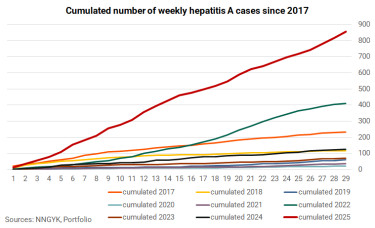Five million peopl ein the EU/EEA living with chronic hepatitis B or C infections
According to recent ECDC estimates,
3.2 million people are living with chronic hepatitis B and 1.8 million with chronic hepatitis C across the EU/EEA.
In the EU/EEA, hepatitis B and C are linked to around 50 000 deaths each year – 15 000 related to hepatitis B and 35 000 related to hepatitis C – with deaths from liver cancer due to viral hepatitis continuing to increase.
Furthermore, research suggests that over 65% of people with hepatitis B and 62% of people with hepatitis C are still undiagnosed and so not receiving care, putting them at a high risk of developing chronic liver disease and liver cancer.
"On World Hepatitis Day, we must underline the critical importance of scaling up efforts to prevent and control viral hepatitis. Chronic hepatitis leads to 50 000 preventable deaths each year, and the number of deaths from liver cancer are increasing," said Marieke van der Werf, Head of Section, Sexually-transmitted infections, blood-borne viruses and tuberculosis.
Prevention measures such as vaccination, improved access to testing and early access to care for individuals diagnosed with infection are essential for a healthier, more resilient Europe.
Chronic hepatitis B and C can slowly damage the liver over years without causing any symptoms until they lead to serious conditions like liver cirrhosis and cancer. The longer that infections go undetected, the higher the personal and public health cost, making early diagnosis and linkage to care critical to break the chain of transmission and prevent avoidable deaths.
Childhood vaccination against hepatitis B, alongside programmes to prevent mother-to-child transmission, have reduced hepatitis B transmission across the EU/EEA, especially among younger age groups.
However, the recent increase in newly reported cases of acute hepatitis B across the region may reflect increasing transmission and highlights the importance of maintaining comprehensive prevention programmes.
The 2030 United Nations Sustainable Development Goals (SDGs) include a global commitment to eliminate viral hepatitis as a public health threat, with concrete targets to diagnose 90% of people living with chronic hepatitis B and C, treat 80% of those eligible, reduce new infections by 90%, and cut hepatitis-related deaths by 65%.
However, current data show that the EU/EEA is not on track: a large proportion of people infected with hepatitis B and C remain undiagnosed, and hepatitis-related deaths have not declined, with numbers of related liver cancer deaths continuing to increase. Therefore, current data indicate that
the EU/EEA needs strong and immediate action to get on track to meet the 2030 SDG targets for viral hepatitis.
On World Hepatitis Day, ECDC renews its recommendations for EU/EEA public health authorities to scale up efforts to tackle viral hepatitis through these key measures:
-
Ensuring high vaccination coverage against hepatitis B through childhood vaccination programmes and for population groups at a higher risk of infection;
-
Improving access to testing for early diagnosis of hepatitis B and C;
-
Supporting harm reduction programmes to stop the spread of hepatitis B and C among people who inject drugs. This includes providing clean needles and syringes, safe places to use drugs under medical supervision, and access to testing and treatment;
-
Ensuring clear pathways to care and treatment. Effective treatments are now available for infections with hepatitis B and C that can reduce disease progression and the risk of severe complications such as liver cancer;
-
Providing accessible care to at-risk groups based on an understanding of their needs.
Massive increase in hepatitis A cases in Hungary
There were 855 hepatitis A cases in Hungary by the end of the 29th week this year.
This is by far the highest figure on record, more than double the previous record of 411 in 2022.
In fact, the number of infections is higher than in the previous three record years combined (758 in total — 231 in 2017, 116 in 2018 and 411 in 2022).

Read the ECDC's hep A factsheet here.
The ECDC reported a multi-country outbreak of hepatitis A in the EU/EEA about a month ago.
Between January and May 2025, Austria, Czechia, and Hungary have reported a higher-than-expected number of hepatitis A virus (HAV) subgenotype IB cases.
- By the end of May, 641 cases had been registered in Hungary, 530 of which were confirmed as HAV.
- The majority of cases were registered in and around Budapest, primarily among adults, although some children were also affected.
- However, only 13 of the registered cases were linked to homelessness.
- During the same period, the Czech Republic registered 600 confirmed cases of HAV, Slovakia registered 880, and Austria registered 87, which was more than expected.
We have enquired at the NNGYK in early July, but haven't got any response every since. Our questions were:
- According to the NNGYK, what is causing this steep rise in Hungary?
- The 13 cases linked to homelessness appear to be negligible, whereas in Slovakia, 47% of cases occurred in Roma communities and 20% were linked to homeless people and/or drug users.
- Have there been more drug users (using needles)?
- Has the infection spread through food?
- Have sanitation conditions deteriorated so much?
We will update this article as soon as we receive a reply from the authorities.







